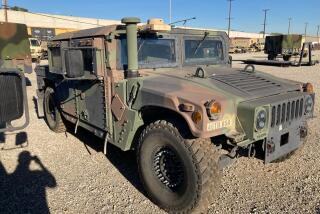From MRAP to scrap: U.S. military chops up $1-million vehicles
- Share via
BAGRAM, Afghanistan — Faced with an epidemic of deadly roadside bombs in Iraq and Afghanistan, U.S. military officials ordered up a fleet of V-hulled 16-ton armored behemoths in 2007 to help protect American soldiers and Marines.
At a cost of $1 million each, the ugly tan beasts known as MRAPS have saved countless lives and absorbed or deflected thousands of insurgent bomb blasts in teeming cities, desert flats and rutted mountain roadways. The lumbering vehicles are so beloved that soldiers have scrawled notes of thanks on their armor.
So why would the U.S. military suddenly start chopping up as many as 2,000 of the vehicles and selling them as scrap? After all, just six years have passed since high-tech MRAPs were developed and 27,000 of them cranked out and shipped in a $50-billion production blitz.
As it turns out, the Pentagon produced a glut of the mine-resistant, ambush-protected trucks. The military brass has now calculated that it’s not worth the cost of shipping home damaged, worn or excess MRAPs to bases already deemed oversupplied with the blast-deflecting vehicles.
As they are “demilitarized,” many of the MRAPs are sold as scrap metal to eager Afghan buyers.
It costs about $12,000 to crunch and dispose of a single MRAP here, said Mark E. Wright, a Defense Department spokesman. To ship one back to the U.S. and rebuild it to current standards would cost $250,000 to $450,000, he said. Selling the vehicles as scrap instead of shipping them home and refitting them will consequently save about $500 million, Wright said.
“Disposing of excess MRAPs in Afghanistan where there is no military or excess defense articles need is fiscally responsible,” Wright said. Through Oct. 1, 938 MRAPs in Afghanistan had been turned into scrap, according to the Defense Logistics Agency.
The first to be crunched were older models and those damaged in bombings or wrecks. Next up were vehicles considered “excess property,” sold as scrap along with banged-up Humvees, pickups, treadmills, office chairs and air conditioners.
MRAPs in good working condition are being offered for sale as-is to approved U.S. military allies. But they are not being offered to Afghan security forces because the Pentagon has concluded that they contain too much sophisticated computer technology for the still-developing Afghan military to operate. Maintenance of the vehicles is also too difficult for Afghan soldiers, more than half of whom are illiterate.
Afghan troops are not known for their dedication to maintaining equipment; they prefer to run vehicles rough and hard until they break down.
There are few Afghan mechanics fully trained to repair relatively simple Humvees, Afghan commanders complain, much less a computer-dependent colossus like the MRAP.
The fire sale has attracted about 380 orders from partner nations so far, Wright said. But with 13,000 excess MRAPs available worldwide, it’s not likely that all those in Afghanistan will be sold. It’s an “as is, where is” deal, Wright said, meaning buyers must also pay the cost of shipping MRAPs out of Afghanistan.
Instead of MRAPs, Afghan forces are receiving armored MSFVs — mobile strike force vehicles — equipped, in military jargon, with an “enhanced survivability package,” at a total cost of $887 million. The vehicles have “innovative protection design features to achieve MRAP level of blast protection,” Wright said.
The Afghan military is also getting leftover American pickups, modular housing and portable toilets, not to mention military bases built with U.S. taxpayer dollars.
Lt. Gen. William Faulkner, the Marine Corp’s deputy commandant, said in a speech in April that the military has too many of the hulking MRAPs.
“The bottom line is, we don’t need them,” Faulkner said. But he’d rather see an MRAP go to a partner nation than for the U.S. to “actually cut it up into razor blades.”
MRAPs provide far more blast protection than the “up-armored,” or armor-enhanced,— Humvees used by American troops here before the MRAP rush order, which circumvented the Pentagon’s sclerotic procurement process. The emergency order was pushed hard by then-Defense Secretary Robert M. Gates because of soaring U.S. casualty rates among troops in Humvees, who were being decimated by roadside bombs.
Gates’ predecessor, Donald H. Rumsfeld, had resisted deploying massive, heavily armored vehicles. He considered them inimical to his vision of a fast, light, maneuverable U.S. military in Iraq.
In a notorious 2004 put-down of Iraq-bound National Guardsmen in Kuwait who complained of poor-quality equipment and of having to scrounge through landfills for “hillbilly armor” for their Humvees, Rumsfeld said, “You go to war with the army you have, not the army you might want or wish to have at a later time. If you think about it, you can have all the armor in the world on a tank and a tank can be blown up. And you can have an up-armored Humvee and it can be blown up.”
Those comments were viewed by some U.S. service members in Iraq as callous and demeaning.
The subsequent rush to develop MRAPs was a clear repudiation of Rumsfeld’s strategy, which failed to anticipate the tenacious and lethal Iraqi insurgency. Rumsfeld stepped down in 2006 when President George W. Bush concluded that the war in Iraq was “not working well enough, fast enough.”
In 2011, Gates said that MRAPs had “saved thousands and thousands of lives,” and are 10 times safer than Humvees. A study published that year by the Pentagon’s Joint Program Office for MRAPs concluded that the vehicles saved 30,000 lives in Afghanistan and 10,000 in Iraq. The study was criticized by some security experts as exaggerated, but they agreed that MRAPs have prevented a significant number of deaths and injuries.
MRAPs have a raised chassis, reinforced floors and suspended seats designed to minimize blast effects from explosions below. They are not a comfortable ride, especially on Afghanistan’s potholed roads and dirt tracks.
Even as 47,000 U.S. combat troops in Afghanistan prepare to return home by the end of 2014, MRAPs are still in use. They occasionally chug through Kabul’s worn streets, infuriating Afghans as the vehicles hog narrow roadways.
However, since U.S. troops have made the transition to a training role and Afghan forces have taken the combat lead, there are fewer MRAPs in action.
Disposing of excess MRAPs is part of an enormous $5-billion to $7-billion moving job that involves shipping U.S. vehicles, weapons, gear and equipment out of Afghanistan. By road and by air, the military plans to remove 35,000 vehicles and 95,000 shipping containers by the close of 2014, according to Army Maj. Gen. Kurt Stein. Excess equipment is being turned into scrap, sold or given to the Afghan military.
The U.S. military denied a Times request to photograph MRAPs being dismantled. But no one stopped Ashton B. Carter, then the U.S. deputy defense secretary, from snapping a souvenir photo of an MRAP being chopped during a recent visit to Afghanistan. Carter told the New York Times he sent the photo to Gates.
“Can’t believe it,” Carter said he told Gates. “They’re taking our babies apart.”
More to Read
Sign up for Essential California
The most important California stories and recommendations in your inbox every morning.
You may occasionally receive promotional content from the Los Angeles Times.











